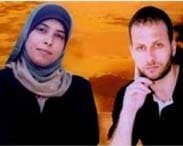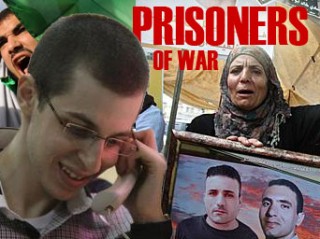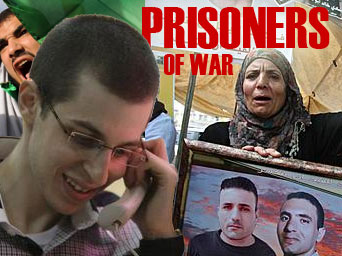
It is time to tell their stories, and to do so without apology.
by James M. Wall
Two young Palestinians, Ahlam (left) and Nezar (right) Tammimi, were among the 477 Palestinian prisoners released from Israeli prisons, October 18.
They were in the first contingent of what is supposed to become more than one thousand Palestinians released in an exchange for Israeli Sergeant Gilad Shalit.
The Western media covered the exchange as a story about the lone Israeli soldier involved. Television captured the dramatic scenes of Israeli Prime Minister Benjamin Netanyahu greeting the young man who had spent five years in an Hamas prison.
The Western public saw and read virtually nothing about the 477 Palestinians who were released from Israeli prisons, except for those stories that reminded the public that many of the prisoners, to use the term so popular among Israeli politicians, had “blood on their hands”.
This bias against Palestinians was so blatant that Jewish activist Noam Chomsky was moved to accuse the media of treating the released Palestinian prisoners as “unpeople”.
It is time to tell their stories, and to do so without apology.
 Western media, taking its lead from the Israeli media, was eager to point out that many of the prisoners were involved in acts that led to the deaths of Israelis.
Western media, taking its lead from the Israeli media, was eager to point out that many of the prisoners were involved in acts that led to the deaths of Israelis.
True enough, but it must also be pointed out that when Shalit was captured, he was part of an army which had been killing Palestinian for decades, civilians and militants.
Shalit was fully armed on patrol with two other IDF soldiers, moving along the Gaza-Israel border. In addition, during the five years Shalit has been in prison, the Israeli Air Force has continued its attacks on Gaza, resulting in many Palestinian civilian deaths.
However one-sided this struggle has always been, it is still a war between the fourth largest military force in the world, and an occupied population, some of whom employ military tactics to resist that occupation.
This brings us to Ahlam and Nezar, two Palestinian prisoners who had known each other briefly before both were imprisoned. They are members of a large, extended Tammimi family.
They had both attended Birzeit University, at different times. As prisoners in separate Israeli jails, they connected again through a correspondence that traveled a circuitous route to the village of each of their parents, and then back to the Israeli prisons where they were incarcerated.
The picture above, from The Media Line’s Mid East News Source, is clearly a composite.
It was through their correspondence that Ahlam and Nezar determined they were in love. Ahlam tells the story of their courtship:
“Each letter would take a month to reach Nezar and another month [for me] to get his response back. I would place the letter in the mail and send it to my family. My family would send it to Nezar’s family. Nezar’s family would send it to him.”“Nezar would go through the same process to send me a letter. Our letters were so precious, they took so much time and they were our only means of communication.
We would share experiences, express our love and share our virtual dreams of being and living together after our marriage. After exchanging letters and falling in love we both decided to get engaged even if we were both jailed for life”.
The Media Line reports on Ahlam’s story of the letters, an account she presented “with a broad smile and a sparkle in her eyes”.
Now that they have been released in the October 18 prisoner exchange, Ahlam and Nezar want to somehow have a “big wedding—as soon as they can finally see each other”.
Their formal marriage came in August, 2005.
The fathers of Ahlam and Nezar arranged the necessary marriage documents and sent the couple copies of the marriage contract. Ahlam reports that Nezar sent her wedding rings but Israeli prison administration officials “confiscated them all”.
The first personal meeting the couple had after their marriage, came five years later, in March, 2010, when Israeli intelligence officers questioned them, together, “about the relationship between them and their future plans”. (This meeting suggests that, at the time, Israel was evaluating potential prisoners for a swap for Sergeant Gilad Shalit)
When Ahlam and Nezar were released on October 18, the IDF—not-so-helpfully–sent the couple to different locations. Nezar returned to a joyous hero’s reception in his home village of Al-Nabi Saleh, a farming center, where his extended family still lives.
Al-Nabi Saleh (The Prophet Samuel) is an Arab village in a valley nestled next to a hill on which a Jordanian Taggert Fort once stood. This particular fort was part of a chain on forts the British built in Palestine during their Mandate period.
The fort had been abandoned until October, 1977, when Prime Minister Menachin Begin allowed The Gush Emunim (bloc of the faithful), an orthodox Jewish group, to establish a settlement on the hill overlooking Al-Nabi Saleh.
Since his return from a meeting with President Jimmy Carter in the summer of 1977, Begin had allowed six Gush Emunim settlements to move into the West Bank, violating an earlier promise Began had made to Carter. The Gush Emunim was–and remains–a radical religious group that maintains it has “a commission from God to recapture the biblical lands of Judea and Samaria”.
On the November, 1977, afternoon when I visited the area at the suggestion of the mayor of the city of Ramallah, I found that 18 Jewish orthodox families and 25 non-orthodox families had established themselves as the Jewish settlement Halamish, on Palestinian land. All of the families lived in the fort.
One of the wives from an orthodox family told me in her quiet Chicago, Illinois, accent, that she and her husband had moved to Israel to claim the land Yahweh had given them.
Prime Minister Begin did not officially “approve” of the six Gush Emunim settlements. But he had arranged to protect them. A small IDF unit was stationed on a hill nearby, their tents an early sign of a long-planned settlement movement sanctioned by and encouraged by, Prime Minister Begin.
Since 1977, Halamish has expanded from its original foothold in the fort to occupy almost half the historic lands of al-Nabi Saleh. Tensions have always been high between Halamish and Al-Nabi Saleh. The most recent clash has come over the issue of land confiscation of property and water.
The blog, JadaIyya, reports on the source of the current protests by both Palestinians and internationals against the actions of the Halamish settlers:
In December, 2009 settlers from Halamish expropriated the natural spring of ‘Ayn al-Kus on the south side of Road 465. Several weeks later, Halamish settlers burned down 150 of al-Nabi Saleh’s olive trees near the spring.
Ahlam, whose family also has roots in Al-Nabi Sahel, was born in Jordan, where her family had moved in 1967. As a condition of her release in the October 18 prisoner exchange, Ahlam was forced to fly to Jordan to join her parents’ family.
She was not allowed to travel with her husband to his family village, Al-Nabi Saleh. The couple was able to meet briefly at Cairo’s Airport’s Sheraton Hotel on their way to their separate destinations.
The Media Line reported on Ahlam’s time in prison and her welcome home in Jordan:
“I was placed in solitary confinement many times, sometimes for a reason and sometimes for no reason. The cell is so small and dark with dark walls and built underground. It’s just like being jailed in a tomb. If I hadn’t of turned to God, praying and Qura’an, I would have lost my mind.” Ahlam recalls.
“Let me share with you a funny story, I was sentenced with an extra year to my 16 lifetimes because I had a fight with an Israeli female prison guard. This incident kept me laughing for days, as if I would care less about an extra year added to my jail time of 1,548 years.” Ahlam says laughing.
Arriving in Jordan, Ahlam says she was overwhelmed when large numbers of family, friends and fans came to Amman’s Queen Alya airport to welcome her.
“I only met my family twice during my 10 years of jail time, which made me drown in despair sometimes. I missed them so much. Meeting my father and the rest of the family means the world to me,” Ahlam says in tears.
Ahlam says she already feels rejuvenated by being reunited with her family. “There is a whole new generation in my family that I missed out on. Photographs and names have turned into people that I am eager to know,” Ahlam adds happily.
This then, is the story of three prisoners carefully selected by Israeli officials to be released from prison. Two of the prisoners, Ahlam and Nezar, were separately arrested, charged and sentenced by military courts. Each was sentenced to life imprisonment.
Their “crimes”, for which a military occupying power had served as jury and judge, were identified and punished according to a military court in a system operated by an illegal occupation.
Israel sees the prisoners as threats to the security of the State of Israel. The Palestinians who were sent to jail, on the other hand, saw themselves as resisting an occupying army, taking actions they believed appropriate to deal with that occupation.
What Israel did is what all occupying, colonizing armies do. They punished those who resisted their colonizing.
Palestinians, for their part, attacked their “enemy” with the same zeal as did Jewish “freedom fighters”, such as the future Israeli Prime Minister Menachem Begin, when he fought British occupiers on behalf of what Begin and his fellow fighters saw as the freedom of the future state of Israel.
What this comes down to is a conflict of narratives, based on who is telling the story, the military occupiers or those who are resisting occupation/colonization.
Ahlam, 31, is younger than her husband, who is 38. Her brother Fakhr Al Tammimi remembers his sister as “a rebellious child with a strong personality. She never took the easy way and always thought out of the box. My sister had Palestine in her heart and always wanted to go back there.”
Ahlam began her studies in media and journalism at Birzeit University in 1998, just at the time when the Second Intafada began. As a student, Ahlam worked for Al-Milad magazine and Al-Istiqlal television station, two local media outlets.
At Birzeit, Ahlam met a Palestinian student who inspired her. He was an Hamas member. In an interview with The Media Line, she said:
“I expressed my desire to join them. He told me he has to ask his superior because Ezzeldin Al-Qassam brigades have no female members. After a few days, he came with an approval, which made me the first female Ezzeldin Al-Qassam brigade member,” Ahlam explains.
Her crime, for which she was sentenced by a military court for multiple life terms, was for “choosing the location and securing transportation to reach that location” for Hamas member Ezz Al Din Al Massri, 20,who blew himself up in Sabarro restaurant in Jerusalem in August 2001, killing 16 Israelis and injuring 150.
From Israel’s perspective, Ahlam played a role in causing a massive act of murder. She saw it, initially, as an act of war. And of course, war itself is organized, sanctioned murder. There is no other way to describe it. There is no simple answer to the question of what separates murder from deaths caused in combat.
US and Israeli drone attacks are acts of indiscriminate killing of both targeted militants and innocent civilians. The victims of such killings cry for revenge, which in turn, leads to more deaths. The entire process is, finally, a senseless cycle.
Many Israelis are angry that Ahlam and 476 other Palestinians who were on the “other side” in this conflict, have gained their freedom. They resent being reminded that their own Israeli military forces are guilty of killing Palestinians.
Governments work hard to justify what their armies do, demonizing the enemy and convincing their civilians that the cause the army fights for is just. This does not, however, make it right.
The fact remains that a limited freedom has been granted to the 477 Palestinians. Ahlan, like her colleagues who have joined her in leaving prison, now looks to the future. What Ahlam wants to do now is to find a way to unite with her husband, Nezar, who was was jailed in 1993 during his Birzeit University years.
Ahlam’s dream now is to settle down after a huge wedding that reunites her with her husband. “All I dream about now is to live with Nezar, settling down and raising our future children”.
Nezar was sentenced to life in prison for belonging to a Fatah cell in 1993, which Israel claimed was responsible for kidnapping and killing an Israeli in the Jewish community of Beit El near Ramallah.
This then is the personal story, the life in prison, and the courtship and marriage of Ahlam and Nezar, who now face an uncertain future.
Ahlam told The Media Line that her hope is that the couple will be reunited in Jordan, but if Nezar does not receive permission to enter Jordan, they will request permission to live in Gaza, hoping for the support of the Palestinian Authority, currently run by Nezar’s party, Fatah, and Gaza’s Hamas government.
Meanwhile, Ahlam is trying to adjust to the new developments in technology that emerged during the time she was in prison. She plans to communicate with her husband with the help of new technology.
“I was told that we can cam-chat with each other using motion picture and voice both at the same time, whatever that means,” Ahlam adds with a laugh, “It certainly sounds like a cooler way to communicate than the mobile telephone.”
Ahmed, who is also Nezar’s cousin, was a third member of the Nabi Saleh Tamnimi family who was released in the prisoner exchange. Ahmed and Nezar were both charged in 1993 with the same “crime”. Their story is told in the five-minute video below. The Youtube video was released by The Palestine Chronicle.
It covers two days in the village of Al-Nabi Saleh, one day before the prisoner release, and on the day two Tammimi family members are welcomed home.
jeaunkes
http://youtu.be/06FM-a1SB6g
This article was first posted @ Wall Writings
James Wall is currently a Contributing Editor of The Christian Century magazine, based in Chicago, Illinois. From 1972 through 1999, he was editor and publisher of the Christian Century magazine. He has made more than 20 trips to that region as a journalist, during which he covered such events as Anwar Sadat’s 1977 trip to Jerusalem, and the 2006 Palestinian legislative election. He has interviewed, and written about, journalists, religious leaders, political leaders and private citizens in the region. Jim served for two years on active duty in the US Air Force, and three additional years in the USAF (inactive) reserve. He can be reached at: jameswall8@gmail.com.
ATTENTION READERS
We See The World From All Sides and Want YOU To Be Fully InformedIn fact, intentional disinformation is a disgraceful scourge in media today. So to assuage any possible errant incorrect information posted herein, we strongly encourage you to seek corroboration from other non-VT sources before forming an educated opinion.
About VT - Policies & Disclosures - Comment Policy




